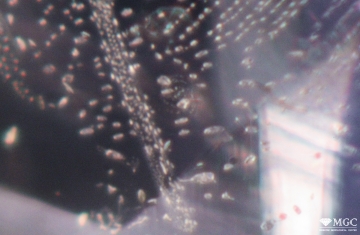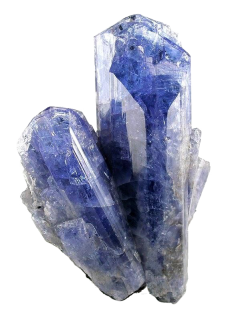open 10 am - 7 pm
laboratory is closed
Tanzanite
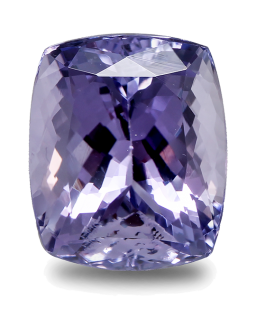
Tanzanite is a gem variety of the mineral zoisite, colored in purple and blue. The gemstone was given the name "tanzanite" by Tiffany & Co. after Tanzania, the country in which it was discovered. The scientific name of "blue-violet zoisite" was not thought to be consumer friendly enough by the marketing department, who introduced it to the market in 1968. Scientifically called "blue zoisite", the gemstone was renamed as tanzanite by Tiffany & Co., who thought that "blue zoisite" (which might be pronounced like "blue suicide") wouldn't sell well. The new commercial name turned out to be very successful and was confirmed for this chrome vanadium variety of zoisite as official, which nobody considered it necessary to challenge.
The history of this stone discovery and name is full of curiosities. On one hand the first samples of tanzanite were found on a ridge near Mererani Hills near Kilimanjaro by a local Ali Juuyawatu or Jaluawatu, who was hunting in 1966. Hunter took it to one of the gemstone wholesaler who were looking for the raw materials of gemstones in the region of the Merelani highland in July 1967. On the other hand (officially announced by the government of Tanzania in 1984), stones were found by a tailor and part-time gold prospector Ndugu Jumanne Ngoma on the road in January 1967. The old man, Manuel de Souza, a shoemaker from India, who was fascinated by the search for colored stones and moved to Tanzania (the city of Arusha), he assumed that the mineral was olivine (peridot) but, after soon realizing it was not, he concluded it was "dumortierite" (a blue non-gem mineral). Manuel D'Souza, in turn, showed the stone to John Saul, a geologist consultant and a wholesaler of gemstones. He, in turn, tried to define the mineral, since none of the definitions of Manuel D'Souza was true. The first precise definition of the mineral "zoisite" was given by Jan McCloud, a geologist working under the government of Tanzania. Subsequently, samples of the mineral were taken to Harvard University, the British Museum and Heidelberg University, and to the Gemological Institute of America in Carlsbad, where they were correctly identified the new gem as a variety of the mineral zoisite.
Chemistry: Ca2Al3(Si2O7)(SiO4)O(OH);
Crystal system: Rhombic, rhombo-dipyramidal crystal class (point symmetry group);
Color: Purple-pink, green (from yellow-green to blue-green), blue, blue, purple to purple, brown, polychrome.
The blue-blue color is due to the admixture of vanadium ions V4+ and V3+ being in octahedral coordination. Brown-violet colors are due to V3+ and Ti3+ ions, as well as a small amount of Fe3+ ions. Different shades of green are due to the impurity of Cr3+ and a small amount of Fe2+ и Fe3+ ions.
During annealing, the valence of the titanium ion Ti3+ → Ti4+ and iron Fe2+ → Fe3+ changes due to a decrease in the valence of vanadium V4+ → V3+, as well as the formation of the donor-acceptor pairs Ti4+ – Fe3+ (Ti3+→Fe4+). Improving of the violet color and removing of unwanted colors being performed as a result. Some researchers indicate an improving in the blue and violet color of tanzanite as a result of preliminary radiation treatment followed by heat treatment of the mineral. This process also promotes the formation of Ti4+ – Fe3+ pairs and the formation of additional V4+ ions in the octahedral position of the crystal lattice, thereby enhancing the blue color component.
Identification properties
| Physical properties | |
|---|---|
| Mohs hardness: | 6 - 7 |
| Density: |
3.15 – 3.36 g/cm3; 3.35 g/cm3 (calculated) |
| Cleavage: | perfect |
| Fracture: | uneven |
| Optical properties | |
|---|---|
| Optical character: | anisotropic, biaxial, positive |
| Refractive Index: | Np =1.685 – 1.705, Nm =1.688 – 1.702, Ng =1.698 – 1.718 |
| Birefringence: | 0.006 – 0.018 |
| Pleochroism: | from clear to strong: blue - purple - yellow-green |
| Dispertion: | 0.030 (BG), 0.011 (CF) |
| Luster: | vitreous |
* Sometimes anomalously biaxial (which refers to twins, and distorted crystals).
Inclusions and structural inhomogeneities
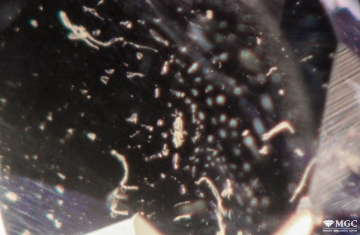
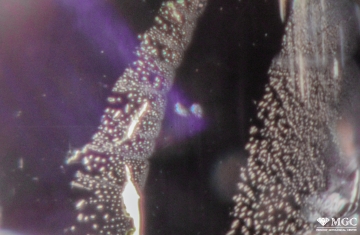
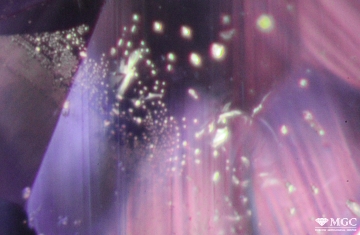
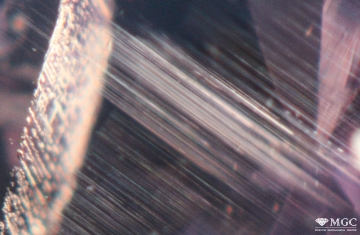

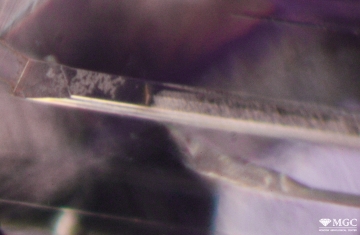
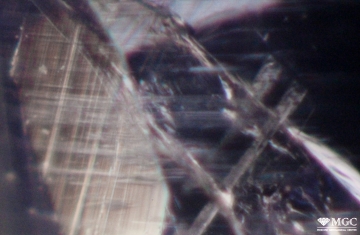
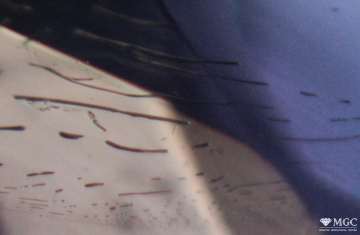
Gem basic treatments
| Treatment | Goal |
|---|---|
| Heat treatment. | Removing of unwanted color shades |
| Irradiation treatment with heat treatment followed | Improving the primary color |
| Surface coating with various coloring compounds | Altering the gem visual color |
| Impregnation of fractures with fillers | Improving the apparent clarity of gem material |
Inclusions and structural inhomogeneities
Synthetic or Imitation gem materials
Actually there is no information on the production of synthetic tanzanite.
The most commonly encountered synthetic tanzanite is as follows:
- synthetic forsterite with a similar color;
- synthetic stones differing in optical properties but similar in color (for example - spinel, YAG, corundum);
- compound stones - doublets, for example tanzanite + glass or tanzanite + spinel;
- color glass.
IMPORTANT
Tanzanit in no case can be washed in an ultrasonic wash. It is best to wash the tanzanite with warm soapy water.


